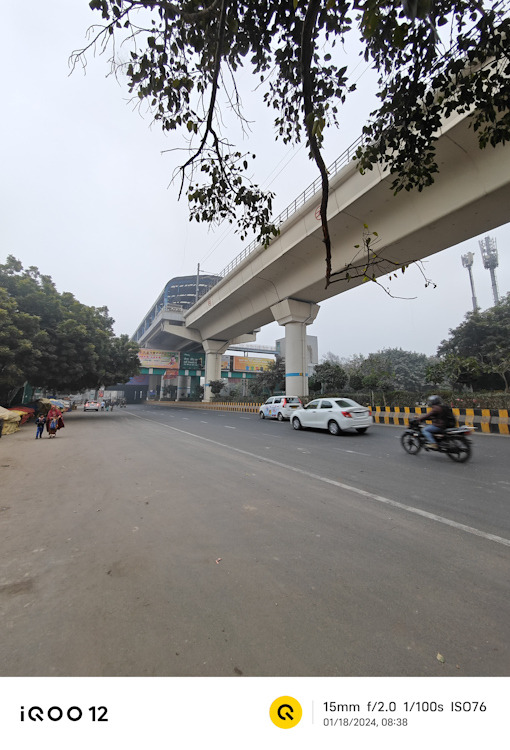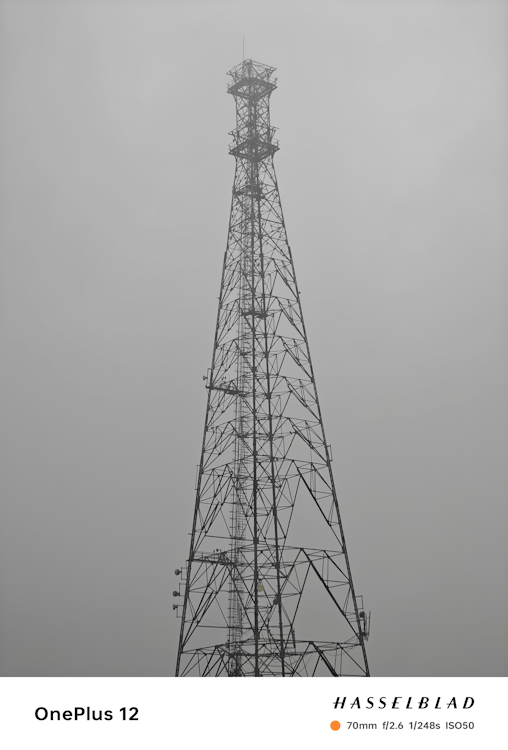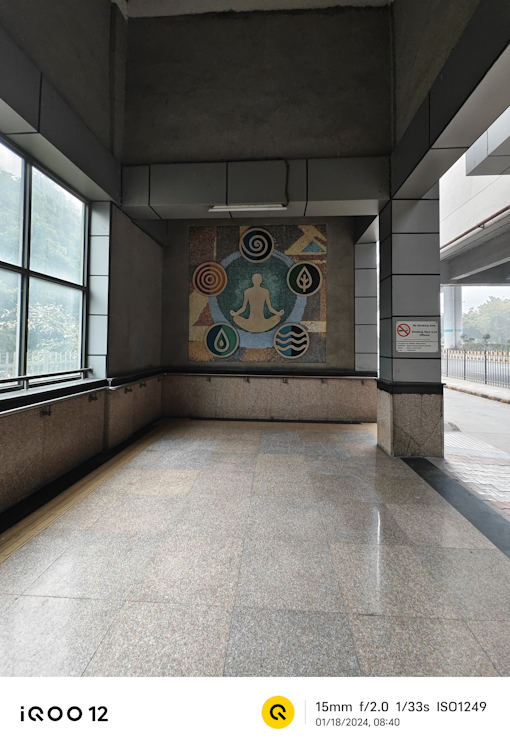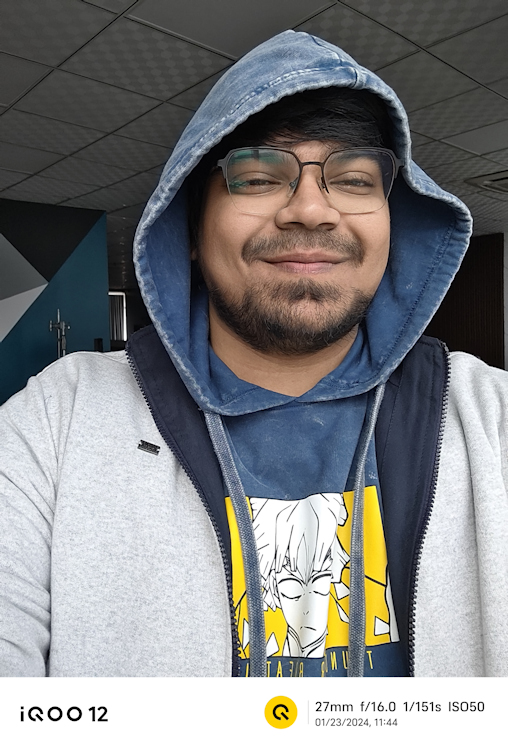- Both the OnePlus 12 and iQOO 12 are powered by the Snapdragon 8 Gen 3 and include very identical cameras.
- Both phones have equally bright and great AMOLED displays with LTPO technology and up to 144Hz refresh rates.
- The OnePlus 12 delivers a better software experience and support for more OS updates compared to iQOO 12.
- The iQOO 12 has a more balanced camera performance, performs better in benchmarks, and is also cheaper.
The OnePlus 12 has finally landed with the latest Snapdragon 8 Gen 3 SoC and a commendable set of cameras. Thanks to a unit provided by OnePlus, I was able to use their latest flagship offering for close to a week ahead of the launch. We also had the iQOO 12 at the Beebom office, which made me want to compare these two flagships. Not only are both phones powered by the 8 Gen 3 chipset, but they also have pretty similar camera setups. So, which emerges superior ultimately? Let’s dive right into this detailed OnePlus 12 vs iQOO 12 comparison and find out!
Specs At a Glance
| Specs | OnePlus 12 | iQOO 12 |
|---|---|---|
| Dimensions | 164.3mm x 75.8mm x 9.15mm | 163.22 x 75.88 x 8.35mm |
| Weight | 220 grams | 203.7 grams |
| Processor | Snapdragon 8 Gen 3 | Snapdragon 8 Gen 3 |
| RAM/Storage | 16GB LPDDR5X/ 512GB UFS 4.0 | 16GB LPDDR5X/ 512GB UFS 4.0 |
| Display | 6.82-inch QHD+ 120Hz LTPO AMOLED, 3168 x 1440, 510 ppi, up to 4500 nits peak brightness | 6.78-inch 1.5K 144Hz LTPO AMOLED, 2800 x 1260, 453 ppi, up to 3000 nits peak brightness |
| Rear Camera | 50MP Main + 48MP Ultra-wide + 64MP Telephoto (3x optical zoom) | 50MP Main + 50MP Ultra-wide + 64MP Telephoto (3x optical zoom) |
| Front Camera | 32MP | 16MP |
| Video | Up to 8K at 24FPS | Up to 8K at 30FPS |
| Dual SIM | Yes; Supports eSIM | Yes; Supports eSIM |
| Connectivity | 5G, Wi-Fi 7, Bluetooth 5.4, LE, NFC | 5G, Wi-Fi 7, Bluetooth 5.4, LE, NFC |
| USB-C | Type C 3.2 Gen 1 | Type C 2.0 |
| Battery | 5,400 mAh | 5,000 mAh |
| Charging | 100W SUPERVOOC Fast Charging, 50W AIRVOOC Wireless Charging | 120W Wired Charging, No wireless charging |
| IP Rating | IP65 | IP64 |
| Software | Android 14-based OxygenOS 14 4 years of OS updates | Android 14-based Funtouch OS 3 years of OS updates |
Design
For your reference, we have with us the iQOO 12 Legend and the OnePlus 12 Flowy Emerald color options. The iQOO 12 Legend is coated in white with iQOO insignia coupled with the BMW M series branding on the rear. Meanwhile, the OnePlus 12 is enveloped in green with some beautiful, darker green ripples on the back. From sheer looks alone, the OnePlus 12 immediately had my attention.
However, there are two things that I really liked about the iQOO 12 in terms of design. Firstly, the unique rounded-square (rhombus?) camera module at the back, surrounded by a textured border. Secondly, when light directly hits the back glass, it creates a pentagram, which is incredibly cool!

Next comes the in-hand feel of both the devices. Even in this regard, the OnePlus 12 felt a lot more premium to me. Yes, part of it has to do with the matte finish at the back, guarded by a metal frame. But, it also has to do with the curved craftsmanship all around. The phone never digs into your skin, allowing you to comfortably use it for hours.
That is not something you can say about the iQOO 12. Even though it is lighter than the OnePlus 12, it wasn’t comfortable to use. The ‘boxy’ design of the phone makes it feel heavier when using it for a long time. Plus, another thing that I noticed was that the iQOO 12 features an aluminum frame, but it did not feel that premium for some reason. The finish probably has something to do with it.
Not to mention that I’m a very clumsy person and I just felt a lot more secure using the OnePlus 12, since it comes with Corning Gorilla Glass 5 protection at the back. Meanwhile, the biggest bummer for me with the iQOO 12 is that it doesn’t come with Gorilla Glass protection. The company doesn’t specify the glass protection on its website. However, going by Vivo’s track record, I’m guessing they are using Schott AG’s Xensation Up protection on the iQOO 12.

The OnePlus 12’s overall curvy design also made it a lot easier to hold, giving it a bit of an anti-slip property. The iQOO 12, on the other hand, was quite slippery in my week-long testing.
While the OnePlus 12 comes with an IP65 rating, the iQOO 12 features IP64. Both are practically the same, so you can expect both phones to stand strong against splashes and accidental spills.
The volume rockers and port placement are also very identical on both phones. However, as we all know, the OnePlus 12 comes with the much-loved alert slider on the left side of its frame. And yeah, the alert slider’s placement has changed, and honestly, I like this much better.
Display

Once I was done admiring the design of both the phones, it was time to turn those displays on. The OnePlus 12 features a 6.82-inch Quad-HD+ AMOLED display with a 3168 x 1440p resolution. This display offers a fast 120Hz refresh rate and is also backed by LTPO technology. Then, comes the surprising bit. OnePlus says that the OnePlus 12 brings 4,500 nits of peak brightness to the table.
I can’t say for sure how often the phone reaches this brightness. But, one thing that I can say is that when we put the OnePlsu 12 against the Galaxy S23 Ultra, iPhone 15 Pro Max, and the OnePlus 11, it was definitely the brightest. You can see the entire video that we posted recently.
But the iQOO 12’s display is no slouch. It is slightly smaller at 6.78-inches and boasts a quad-HD+ (2800 x 1260 pixels) LTPO AMOLED display. However, you get to see a faster 144Hz refresh rate and up to 3,000 nits of peak brightness.
However, when it came to viewing content on the devices, I could barely see any difference. These are top-quality panels and whether it was the color reproduction, viewing angles, or just the overall picture clarity, both phones felt very identical. Using them in brightly lit indoors or sunny outdoors, both phones get plenty bright, and I have no complaints.
From binge-watching Suits and Jack Reacher’s latest season to even rewatching The Batman on Netflix, I never had a problem with either of the phones. The blacks were prominent on both, and so were the different color profiles when viewing content and both of these displays delivered.
Also, do note that iQOO 12 does not have Corning Gorilla Glass on top. Instead, you see Schott AG’s Xensation Up glass protection. Whereas, the OnePlus 12 comes with Gorilla Glass Victus 2, making it less likely to break during bumps and drops.
Speaker Quality
While we are on the topic of entertainment, it’s also important to talk about the stereo sound output on both the OnePlus 12 and iQOO 12. I generally use John Wick 4’s Le Castle Vania to test the audio quality of smartphones and laptops, since it has a lot going and a good pair of speakers will be able to capture all of it nicely.
So, I played this track on both phones, and the 1:41 mark is when the audio starts building up to the beat drop. And well, the OnePlus 12’s speaker setup couldn’t capture that buildup well.
However, the iQOO 12 did so beautifully while maintaining the overall essence of the track. So, in terms of audio quality, I would go with the iQOO 12. The OnePlus 12 has a solid set of speakers too. However, it is just too bass-heavy for my taste and not rich like the iQOO 12.
Cameras

Talking about the cameras, the OnePlus 12 features a top-of-the-line 1/1.4-inch 50MP Sony LYT-808 primary sensor with an f/1.6 aperture and OIS. In addition, there is a 48MP Sony IMX581 ultra-wide-angle sensor with an f/2.2 aperture. Lastly, you also get a 64MP OmniVision OV64B periscope telephoto sensor with an f/2.6 aperture and 6x optical zoom. At the front, you have a 32MP Sony IMX615 sensor.
Talking about the iQOO 12, there is a 50MP Omnivision OV50H primary sensor with an F/1.68 aperture and OIS. It is accompanied by a 64MP Omnivision OV64B sensor telephoto sensor with an f/2.57 aperture that offers 3x optical zoom. There is a tertiary 50MP Samsung JN1 sensor sensor with an f/2.0 aperture.
Enough about the on-paper camera specifications. Here’s how they perform in real life:
Human Subjects
The human skin is not an easy thing to capture accurately. On both devices, not a whole lot of skin smoothening is going on. You can see the details clearly when you zoom in. However, the iQOO 12 has slightly better details than the OnePlus 12 indoors. But, yes, while the iQOO 12s’ camera boosts the picture’s colors, the OnePlus 12 tries to maintain the natural color tones.


Meanwhile, the latter triumphs over the former in outdoor shots. Additionally, the portrait modes are also very well done on both phones. Now, although I have no complaints when it comes to edge detection, the OnePlus 12 just seemed more natural to me. I even liked the depth of field on the OnePlus 12 better. However, the iQOO 12 had more exuberance and vividness in its pictures, while minimalizing on the depth of field a bit. Furthermore, the iQOO also seems to deliver warmer tones as compared to OnePlus’ cooler tones.


Daylight
Both the OnePlus 12 and iQOO 12 are equally great at capturing photos during the daytime as well. However, I noticed that the OnePlus 12 was slightly better at keeping the overall white balance and contrast of photos in check. Moreover, the dynamic range of the OnePlus 12’s shots was better. That, coupled with HDR, automatically gave it a win here over the iQOO 12.


Night-time
If you want to truly test out a phone camera’s capabilities, nighttime is the best time to do so. It is challenging to capture the true essence of the night, and a properly optimized night mode can do so without breaking much sweat.
The good thing is that both the OnePlus 12 and iQOO 12 take impressive night mode shots. But, yet again, there is some unnatural processing on the iQOO 12. On top of that, the iQOO 12 does take a couple of seconds to process a night mode shot. Whereas, the OnePlus 12 just captures visibly better low light shots.


The iQOO 12’s night mode shots are just a tad too bright, making the nighttime seem more like it is evening. However, I did notice that the iQOO 12 maintained the exposure levels better, preventing light sources from blowing up. When zooming in though, both the devices maintain good detailing.
Additionally, the iQOO 12 has a dedicated Supermoon mode, which allows you to specifically take pictures of the moon (like you probably always wanted to). This works much like how Samsung’s AI camera feature works. So, yes, it is AI-generated but works very well. I tried to replicate the effect with the OnePlus 12’s pro mode, but it failed to capture those details like a normal camera probably should. However, the OnePlus 12 is the realist here.




Telephoto
Now, let’s talk about the telephoto sensors on both the phones. OnePlus 12 comes equipped with 3x optical zoom and up to 120x digital zoom support. The iQOO 12, on the other hand, packs 3x optical zoom and 100x digital zoom. So, I turned the HDR on and took some shots with both the phones at 1x, 3x, and 10x optical zoom.








On both the phones, I noticed that shots up to 10x or slightly more were usable. The iQOO shots are slightly more contrasty but offer the sharpness and crispness in details that the OnePlus 12 lacks. Up until 20x, this was the case. However, do note that beyond 20x, both the telephoto sensors start taking identical photos.
Ultra-Wide
Ultra-wide-angle shots are pretty good on both the OnePlus 12 and iQOO 12. However, the former can’t handle shadows well and images often turn out slightly darker. Whereas, the latter takes some balanced ultra-wide shots, emerging as the better sensor in this regard. But, do note that both the phones have no problem with capturing details well.






There was also a bit more noise in the OnePlus 12’s pictures. Whereas, the iQOO 12 handles all the elements well, while maintaining a good dynamic range and white balance in the photos.
Selfie Camera
The selfie shooter is also pretty good on both flagships. However, the iQOO 12 manages to capture slightly better details. The OnePlus 12 retains the natural skin tone, whereas iQOO 12 does a bit of unnatural processing, which I personally didn’t like. The OnePlus 12’s ProXDR is an added bonus to further enhance the shots.




However, you will notice that one of the phones takes over exposed photos at times. But yes, when it comes to portrait shots with the selfie shooter, the OnePlus 12’s edge detection is more natural and accurate.
Videos
Talking about videos now, I could barely spot a difference in quality between the iQOO 12 and the OnePlus 12. Both the phones’ primary sensors are capable of capturing 4K videos at 60 FPS and 8K videos too. However, while the OnePlus 12 was capped at 8K 24FPS, the iQOO 12 could capture at a proper 30FPS, which was noticeably more fluid. We have interlinked the OnePlus 12 and iQOO 12 video samples here for your reference.
As for the front shooter, there is a big difference. While the OnePlus 12 can capture 4K at 30 FPS, the iQOO 12 is limited to 1080p at 30 FPS. You can look at the samples to spot the clear difference in quality and how OnePlus easily bags the win here.
Performance
Finally, we have arrived at the performance bit of this comparison. I have divided it into three key segments for better judgment. So, let’s take a look.
Benchmarks
Before getting into benchmarks, do note that even the OnePlus 11 did not score well in benchmarks. The top-of-the-line OnePlus phones never perform as well as the other phones with the same SOCs in benchmarks.
But, does that translate to poor performance in real life? During my testing, although the OnePlus 12 lagged slightly behind in benchmarks compared to iQOO 12, it is a formidable performer. With that being said, here’s a quick look at the series of tests that I ran for both devices:
Day-to-Day Usage
I used both the OnePlus 12 and iQOO 12 for around a week and never had an issue when using them on a daily basis. I never faced any jitters or lags and both the phones performed like they should. To push them, I did everything I could, from opening 20 apps in the background to having over 40 tabs open on Chrome. The phones did not break any sweat, whatsoever.
It was clear at this point that these are true flagships that allow you to multitask without hitting any threshold wall. RAM management was also supreme on both the phones, and I could easily resume right where I left an app running in the background. That was pretty commendable too.
Gaming

Since both the phones are powered by the Snapdragon 8 Gen 3 chipset, the gaming performance is amazing across the board. Additionally, the processor is backed up by LPDDR5x and UFS 4.0 tech, further adding to the overall seamlessness when gaming. I played a bunch of games on both devices and here’s how it went down:
| Games | FPS/Settings |
|---|---|
| Genshin Impact | Maximum Graphics – 60FPS |
| Fortnite (including Lego Fortnite) | Epic Settings – 60FPS High Settings – 90FPS |
| CoD Mobile | Medium/Ultra Settings – 120FPS (Multiplayer), 90FPS (Battle Royale) Very High/Max Settings – 60FPS (Multiplayer and Battle Royale) |
| BGMI | Smooth Setting – 90FPS Ultra HDR + Ultra FPS – 40FPS |
Both phones could play all the above games in the maximum possible settings. However, when we were playing Genshin Impact, I had a better experience on the iQOO 12. While the performance was the same, the iQOO 12’s 4D Game Vibration feature elevated the experience.
With this feature, every different Genshin Impact character brings a distinct game vibration that can be felt at the back panel. In addition, the Frame Interpolation feature brought added smoothness to the game on iQOO 12, giving it a bit of leverage over the OnePlus 12. The rest of the games played out very smoothly on both phones. There were no frame drops or lags of any kind.
So, all the games I have listed above are some of the most graphic-intensive smartphone games ever made. Plus, when playing these games on the OnePlus 12 and the iQOO 12, the temperatures never went beyond 37 degrees. Although it is the winter season now, you can expect not more than 43 degrees during Summer either. The iQOO 12’s VC technology works very well, and it shows.
The OnePlus 12 is no exception either and never got even slightly uncomfortable in hand, even when I was running Genshin Impact in the maximum possible settings. I can say that these are two of the best gaming phones you can get right now.
Battery Backup and Charging

The OnePlus 12 packs a 5,400mAh battery unit, coupled with 100W SUPERVOOC fast charging support. On the other hand, the iQOO 12 includes a 5,000mAh battery, paired with 120W wired charging.
I put these on-paper specifications to the test. I did around 2.5 hours of gaming, ran all the major benchmarks you saw above, watched YouTube videos, and streamed Netflix for around 3 hours on both the phones. Also, do note that AOD (Always-On Display) was turned off during this testing. I charged the phones fully and started my test.
While the OnePlus 12 could deliver 6.5 hours of screen-on-time, the iQOO 12 gave an insane 7.5 hours of screen-on-time. The iQOO 12 definitely takes the win in terms of battery optimization here.
As for charging speeds, the OnePlus 12 could charge fully in around 23 minutes, as advertised, the iQOO 12 took around 30 minutes. Now, do note that the OnePlus 12 not only has a larger battery but slightly slower fast charging support as well. So, it is remarkable that it charged fully at the time that it did.
Connectivity

In terms of connectivity, both the phones are identical. You get to see WiFi 7 and Bluetooth on both phones. Additionally, there is also Bluetooth 5.4, along with stereo speakers at the top and bottom as well.
There is also dual-SIM support on both devices, alongside a USB Type-C port. However, while the OnePlus 12 has a 3.2 Gen 1 port, the iQOO 12 has an outdated Type 2.0 port.
Another area where the OnePlus 12 takes the lead (at least in India), is the number of 5G bands it comes with. While there are 19 5G bands on the OnePlus 12, there are only 12 5G bands supported on the iQOO 12. There is also NFC support on both the phones.
Software Experience

The software experience is where the OnePlus 12 easily beats the iQOO 12 in my experience, and it is thanks to OxygenOS. Although it does come down to your personal preference, I have no doubt that Funtouch OS 14 on the iQOO 12 feels very outdated. Whether you are on the lockscreen or the app drawer, everything lacks the premium feel that OxygenOS 14 has.
Not to mention that with the latest Oxygen OS 14, there are so many cool features like the File Dock and Smart Cutout features that I ended up using on a day-to-day basis. It just made getting through my everyday tasks easier. On the other hand, Funtouch OS 14 on the iQOO 12 has a ton of features, but it’s not as smooth as OxygenOS. I did find myself using the minimized app windows on iQOO 12 but that’s all. Moreover, the animations felt very clunky too, making this not hit the spot as a power-packed phone like it should.
When using Funtouch OS 14, I also encountered some annoying bugs like not being able to swipe to go back to the home screen when a YouTube video was in fullscreen mode. Meanwhile, the OnePlus 12 just offered a bug-free experience.
Final Verdict
All things considered, if you ask me, the OnePlus 12 just seems more feature-packed. Although the iQOO 12 is cheaper at Rs 52,999 in India, it just fails in the software department, big time. It is not just that the Funtouch OS fails to hit the spot, but also that iQOO offers only 3 years of OS updates. On the other hand, the OnePlus 12 comes with 4 years of OS updates, which is amazing.
The iQOO 12 has been out for some time now and has received several updates since its release, but its software performance still feels lackluster. OxygenOS just felt a lot better. Then comes the design and overall feel of the phones, where the OnePlus 12 easily takes the lead for me. Not to mention, a big con of the iQOO 12 is the absence of any screen protection.
That brings me to the insanely bright and vivid displays on both phones, which offer unparalleled visibility in any given scenario, so no winners in that department. However, the iQOO 12 does offer a more balanced set of cameras, whereas the OnePlus 12’s cameras are not well-optimized. I hope the company rolls out a Day 1 patch to fix the issues.
So, if you want a more balanced phone in the long run and can extend your budget to the Rs 64,999 asking price, then the OnePlus 12 is the ideal choice here. However, if you are on a strict budget, the iQOO 12 is a good all-rounder flagship phone to go with. Ultimately, no smartphone is perfect, and you just need to go with the one that your budget and requirements fit the best.
With that being said, let me know in the comments which phone seems like a better option to you!











